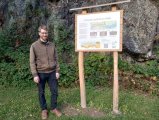News
Ladislav Slavík is the newly elected Chairman of the International Subcommission on Devonian Stratigraphy
Ladislav Slavík was re-elected the Chairman of the Subcommission on Devonian Stratigraphy (SDS/International Commission on Stratigraphy of the IUGS) https://devonian.stratigraphy.org/ and his new term in office began at the 37th International Geological Congress in Busan, South Korea in August 2024. The Devonian Subcommission includes over 150 members from five continents who contribute biostratigraphic, sedimentological and chemophysical proxy studies to refine Devonian stratigraphy and define new international chronostratigraphic standards (GSSP).
A new look on Neoproterozoic evolution of rocks in central and western Bohemia
Owing to a series of interconnected scientific projects, researchers of the Department of Geological Processes of the Institute managed to decipher – together with their colleagues from the Faculty of Science, Charles University – the formation of rocks in central and western Bohemia during the Neoproterozoic. Sedimentary, volcanic and deformational processes in this region could be characterized, and the results were published in prestigious scientific journals (e.g., here and here). This research also showed a public outreach, materialized in an article for the Vesmír journal and an educational panel at the foot of a rock section at the Štěchovice Dam.
An interview on the effects of a lightning
Researchers of the Department of Paleomagnetism of the Institute of Geology gave a short interview related to the study of soil samples taken from the immediate vicinity of a tree struck by a lightning at Vratislavice, where eighteen people were injured in June this year. A report with this interview (starts at approximately 17:58) was broadcast by Czech Radio on Tuesday, September 10, 2024. The research is carried out within a subproject of the Strategy AV21 programme, the general goal of which is to investigate changes in magnetic properties of igneous and sedimentary rocks, soils or even wood after lightning strikes.
Completion of a long-lasting collaboration on a Slovenian cave
The 37th International Geological Congress in Busan (Korean Republic) announced the decision of the Executive Committee of the International Union of Geological Sciences (under UNESCO; IUGS) of 21 February 2024. This decision included the Račiška pečina Cave (Matarsko podolje, SW Slovenia) in the IUGS Geoheritage Sites list. Its justification stated: multidisciplinary record of landscape and palaeoenvironmental change within the last 3.4 million years, including geomagnetic field variations in the Pliocene and Pleistocene including the Matuyama/Brunhes transition. The cave features a unique flowstone section with clays containing abundant fauna of small and large vertebrates and gastropods. The long-lasting research, conducted from 2004, employed a combination of geomorphological methods with numerical radiometric dating (U-Th, U-Pb, 14C), correlative stratigraphy based on fossil remains, and stable isotope (O, C) study which contributed to palaeoenvironmental interpretations. This result is credited to an international team of scientists from Slovenia (ZRC SAZU Karst Research Institute, Postojna), Czechia (Institute of Geology of the Czech Academy of Sciences, v. v. i., Department of Zoology of the Faculty of Science of Charles University, Prague, National Museum in Prague) and Poland (Institute of Geological Sciences of the Polish Academy of Sciences, Warsaw, Adam Mickiewicz University, Poznań). For references to some papers resulting from this research click here and here.
News archive
Looking for older news? Visit the news archive (news older than one year).





